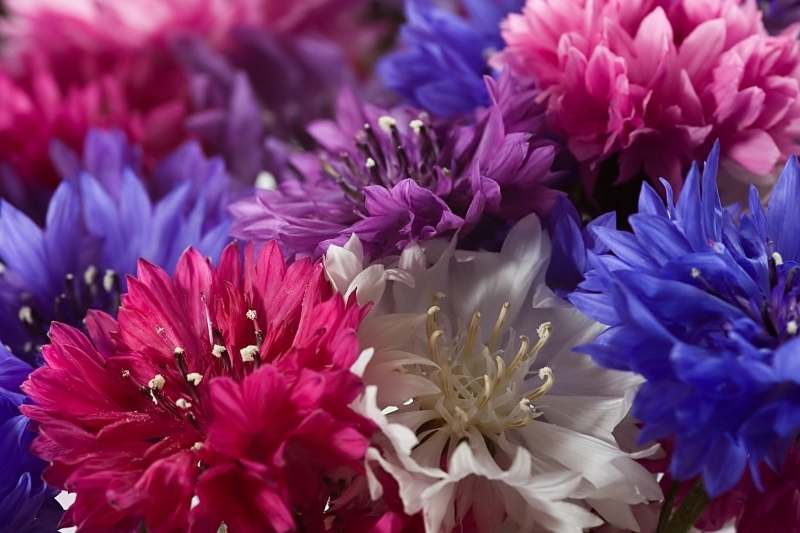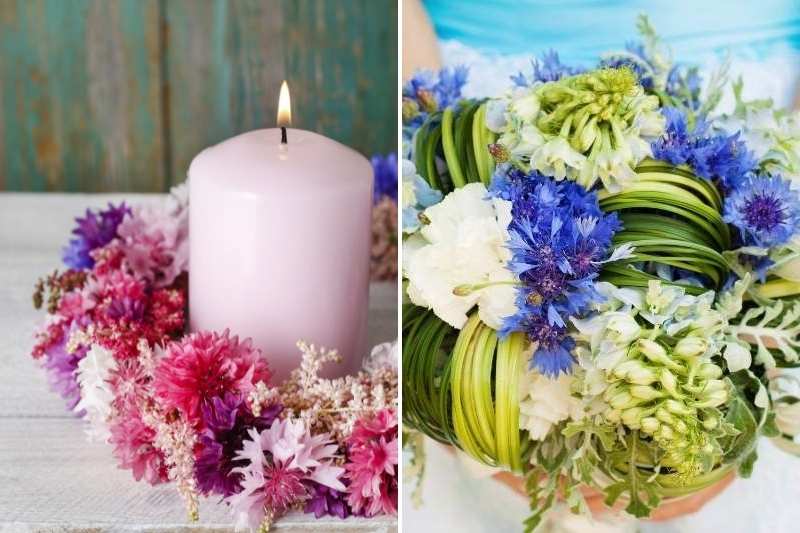Centaurée or Centaurea is a perennial and sometimes annual with single flowers. It occurs in many varieties of shapes and colours. Best-known varieties are Centaurea montana and Centaurea cyanus, also called cornflower. Some species occur wild in France.
Easy to grow at home: they grow in any soil and tolerate drought.
Their simple wildflower beauty, repeated flowering and long stems make them excellent candidates for bouquets. Why not dry them to enjoy all year round?
Centaurea cyanus, edible and soothing, also comforts as an herbal tea, alone or blended with other dried herbs. It also gives a cheerful tint to flavoured teas.

Soft tones of dried centaureas in a bouquet
Centaurée varieties and colours
Think of intense blue flowers of Centaurea cyanus and deep blue of Centaurea montana. Centaureas are also available in many other colours.
- There are pink-flowered varieties, from pale pink of Centaurea montana ‘Carnea’ to vivid magenta of Centaurea dealbata ‘Steenbergii’.
- Others have yellow flowers: pale yellow of Centaurea montana ‘Sulphurea’ and golden-yellow giant flowers of Centaurea macrocephala.
- There are also lovely white varieties such as Centaurea montana ‘Alba’ and dark varieties like ‘Black Sprite’ or ‘Jordy’.
- Most surprising are bicoloured forms, very pretty: Centaurea montana ‘Amethyst in Snow’ and ‘Purple Heart’ with white florets and purple centres.
Let’s not forget their relative, the small Galician Serratula with bright mauve colour.
Form varies too, some slightly tousled, others pom‑pom shaped like the attractive Centaurea ruthenica.

When to pick centaurea flowers?
Depending on variety, picking time ranges from April to September. Perennial varieties, such as Centaurea montana, flower from April to June. Centaurea cyanus and Centaurea moschata, both annuals, flower slightly later: June to August for the first and July to September for the second.
Pick on a fine sunny day or at least in dry weather, ideally in morning once dew has gone.
Choose freshly opened flowers, at their peak, or just opening rather than fully open; leave out blooms that already look a little tired.
Multiple harvests are possible as they renew regularly. Drying results vary: intense colours like Centaurea cyanus or dark flowers retain colour better than paler varieties. Don’t hesitate to experiment!

How to dry them?
Air drying: simplest method, very suitable for centaurea flowers
Proceed as follows:
- Once stems and flowers are selected, trim stems if needed so they are roughly equal length;
- Make bunches of 5 to 10 stems, remove lower leaves at point where you will tie them;
- Tie bunches with a natural string such as raffia. Tie firmly: they will shrink while drying;
- Hang upside down so heads do not touch. Hang from coat hangers, a grid if available, or a clothesline;
- Keep out of direct light or wrap bouquets in kraft or tissue paper. After one week to one month depending on flower size, they will be dry. Check: if they crumble, drying is complete.
Silica gel drying: to better preserve colours
This can be a good alternative for pale colours and pom‑pom shapes.
Method:
- Line bottom of a sealable box with silica gel;
- Lay flowers flat;
- Cover flowers with silica gel;
- Seal box and wait several days, check and leave a few more days if necessary.
How to store them?
Store dried flowers away from light. To preserve colours longer avoid direct sun and very bright places. For longevity, display in dry rooms rather than humid ones.
Leïla’s tip: to prevent dust build-up, I gently blow with a hairdryer on low heat over my dried flowers.
Finally, arrange them in a suitably sized vase for floral compositions.
Using in bouquets
Have fun making pretty bouquets from different dried flowers
Blue centaureas brighten typical dried bouquets in beige, white and green tones.
Create a delicate bouquet by adding pale-pink flowers. Add purple or yellow for more vigour. A burgundy red brings a sophisticated note.
You can also decorate candles with dried flowers. Make wreaths or create cloche displays.

Charming on a candle ring, centaureas also make beautiful bouquets to dry
Cornflower herbal tea
Centaurea cyanus, also called cornflower and sometimes known as bachelor’s button, is enjoyed as an herbal tea. It colours infusions a violet hue while offering benefits. Known for anti-inflammatory and soothing properties for throat.
Sow this annual in March/April for flowering from June to August. If drying cornflower for consumption only, detach flower heads from stem and strip leaves. Lay flowers flat in a single layer in a dry, ventilated, dark place. After a few days they will be dry. Store dried flowers in kraft paper up to 1–2 years to preserve properties.
Cornflower has a mild flavour. Enjoy its benefits blended with other dried herbs or mixed into flavoured teas such as Earl Grey.

































Comments